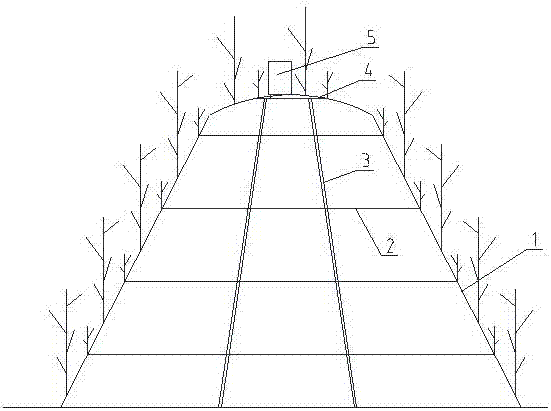Undergrowth wild planting simulation method for rhizoma polygonati
A planting method, the technology of Dianzhong, which is applied in botany equipment and methods, fertilization methods, horticultural methods, etc., can solve the problems that the yield and quality cannot meet expectations, the growth of Dianzhong is uneven, and the cultivation technology is not perfect, etc. Achieve the effect of maintaining forest ecological balance, alleviating market supply tension, and saving production costs
- Summary
- Abstract
- Description
- Claims
- Application Information
AI Technical Summary
Benefits of technology
Problems solved by technology
Method used
Image
Examples
Embodiment 1
[0028] The imitation wild planting method under the forest of Prunus yunnanensis described in present embodiment 1, comprises the following steps:
[0029] ①Selection of forest land: choose the forest land with tall evergreen broad-leaved forest and mossy dwarf forest on the surface as planting land 1. The ecological environment of the selected planting land 1 is 800m above sea level, with a slope of 30°, annual rainfall of 1000mm, growing season The temperature is 22°C, the temperature in winter is above 0°C, frost-free and foggy, the climate is humid, the soil is weakly acidic, has good water storage and air permeability, loose, rich in organic matter, and the light transmittance is 20%;
[0030] ②Soil preparation: When preparing the land, first remove the miscellaneous shrubs, weeds and sundries on the planting land 1, then dig the planting land 1 to a depth of more than 25cm, apply 2000kg of decomposed farmyard manure and 30kg of superphosphate per mu of planting land 1, an...
Embodiment 2
[0043] The imitation wild planting method under the forest of Prunus dianthus described in present embodiment 2, comprises the following steps::
[0044] ①Selection of forest land: choose the forest land with tall evergreen broad-leaved forest and mossy coppice on the surface as planting land 1. The ecological environment of the selected planting land 1 is 1500m above sea level, with a slope of 60°, annual rainfall of 1500mm, and growing season The temperature is 25°C, the temperature in winter is above 0°C, there is no frost and fog, the climate is humid, the soil is weakly acidic, has good water storage and air permeability, loose, rich in organic matter, and the light transmittance is 25%;
[0045] ②Soil preparation: When preparing the land, first remove the miscellaneous shrubs, weeds and sundries on the planting land 1, then dig the planting land 1 to a depth of more than 25 cm, apply 2500 kg of decomposed farmyard manure and 40 kg of superphosphate per mu of planting land...
Embodiment 3
[0058] The imitation wild planting method under the forest of Prunus yunnanensis described in present embodiment 3, comprises the following steps::
[0059] ①Selection of forest land: choose a forest land with tall evergreen broad-leaved forest and mossy dwarf forest on the surface as planting land 1. The ecological environment of planting land 1 is 2000m above sea level, with a slope of 90°, annual rainfall of 1600mm, and growing season The temperature is 28°C, the temperature in winter is above 0°C, frost-free and foggy, the climate is humid, the soil is weakly acidic, has good water storage and air permeability, loose, rich in organic matter, and the light transmittance is 30%;
[0060] ②Soil preparation: When preparing the land, first remove the miscellaneous shrubs, weeds and sundries on the planting land 1, then dig the planting land 1 to a depth of more than 25cm, apply 3000kg of decomposed farmyard manure and 50kg of superphosphate per mu of planting land 1, and then A...
PUM
 Login to View More
Login to View More Abstract
Description
Claims
Application Information
 Login to View More
Login to View More - R&D
- Intellectual Property
- Life Sciences
- Materials
- Tech Scout
- Unparalleled Data Quality
- Higher Quality Content
- 60% Fewer Hallucinations
Browse by: Latest US Patents, China's latest patents, Technical Efficacy Thesaurus, Application Domain, Technology Topic, Popular Technical Reports.
© 2025 PatSnap. All rights reserved.Legal|Privacy policy|Modern Slavery Act Transparency Statement|Sitemap|About US| Contact US: help@patsnap.com

